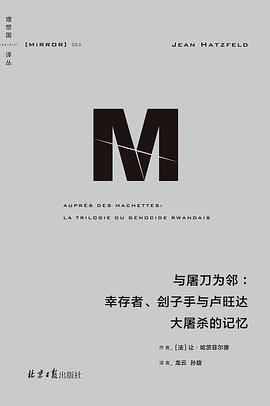WULOLIFE
《与屠刀为邻:幸存者、刽子手与卢旺达大屠杀的记忆》作者: /出版社: 北京日报出版社
《与屠刀为邻:幸存者、刽子手与卢旺达大屠杀的记忆》作者: /出版社: 北京日报出版社
Couldn't load pickup availability
Description
内容简介· · · · · ·
★ 关于卢旺达大屠杀的经典作品,屡获国际殊荣和读者赞誉
★持续十四年实地调查,关注屠杀惨剧的第一现场和劫后余波
★集合数十位当事人的口述文字,同时记录受害者和加害者的声音
★ 还原不含杂音的事实真相,直面人性的幽微之处
发生在卢旺达小镇尼亚马塔的大屠杀开始于1994年4 11 years 11 years 11 years 11 years 11 years 11 years 11 years 11 years 11 years 11 years 11 months 11 years 11 years 11 years 11 years 11 years 11 years 11 years 11 years 11 years 11 years 11 years 11 years 11 years 11 years 11 years 11 years 11 years 11 years 11 years 11 years 11 years 11 years 11 years and 11 years 11 years 11 years 11 years 11 years 11 years 11 years 11 years 11 years 11 years 11 years and 11 years点,胡图族民兵和平民在尼亚马塔的山岗上屠杀图西人。当地约六万名图西人,有近五万死于屠刀之下。
他们生活在一片土地上,是邻居、同事、朋友、爱侣甚至家人。有的胡图人前一天还曾和图西朋友一起喝酒聊天,可一夜之间,他们就拿起了屠刀,有组织地对所有图西人展开屠杀。一部分图西人钻进沼泽、树林和山上,每天像猎物躲避猎人似的逃命,白天吃生食、喝露水,晚上睡在泥浆里,好不容易才活到了屠杀结束。然而,当他们回到镇上,却发现刽子手并未得到应有的惩罚,他们得像从前一样,和这些胡图人继续生活在一起……
大屠杀期间究竟发生了什么?胡图人为什么要这样屠杀图西人?屠杀过后,他们该如何继续生活?带着这些问题,住在当地经过长达十四年的走访调查,采访了众多幸存者和屠杀者,力图从多个角度还原大屠杀的真相,理解这场发生在我们这个时代的人类浩劫。
「名家推荐」
哈茨菲尔德笔下那些独一无二的声音迫使我们去直面不可想象、不能想象之事。弄清卢旺达当年究竟发生了什么,是一项极其艰巨的任务,可我们没有权利就此逃避它,这是我们作为一个有道德的成年人理应肩负的责任。每一个人都本书。
——苏珊·桑塔格
哈茨菲尔德在这本书中记录了卢旺达大屠杀刽子手们的声音,读来令Note:
——菲利普·古雷维奇,《向您告知,明天我们一家就要被杀》作者
Description存者与屠杀者在屠杀之后的记忆与生活。作者堪称我们这个时代最伟大的法国作家之一,他的身影虽然很少出现在书中,但他的文字足以彰显他那伟大的灵魂。这部作品以微妙的语言,运用口述史这种看似古老原始的方式,使人性最幽暗的角落。
——《纽约客》
书中的每一段讲述都同样痛彻心扉,每一个声音都独一无二。若是在别人手里,它们可能只是一些零散收集的故事,但哈茨菲尔德把这些故事汇聚起来,赋予它们以力量,迫使人们对这个时代的种族灭绝做出积极的回应。
——《出版人周刊》
